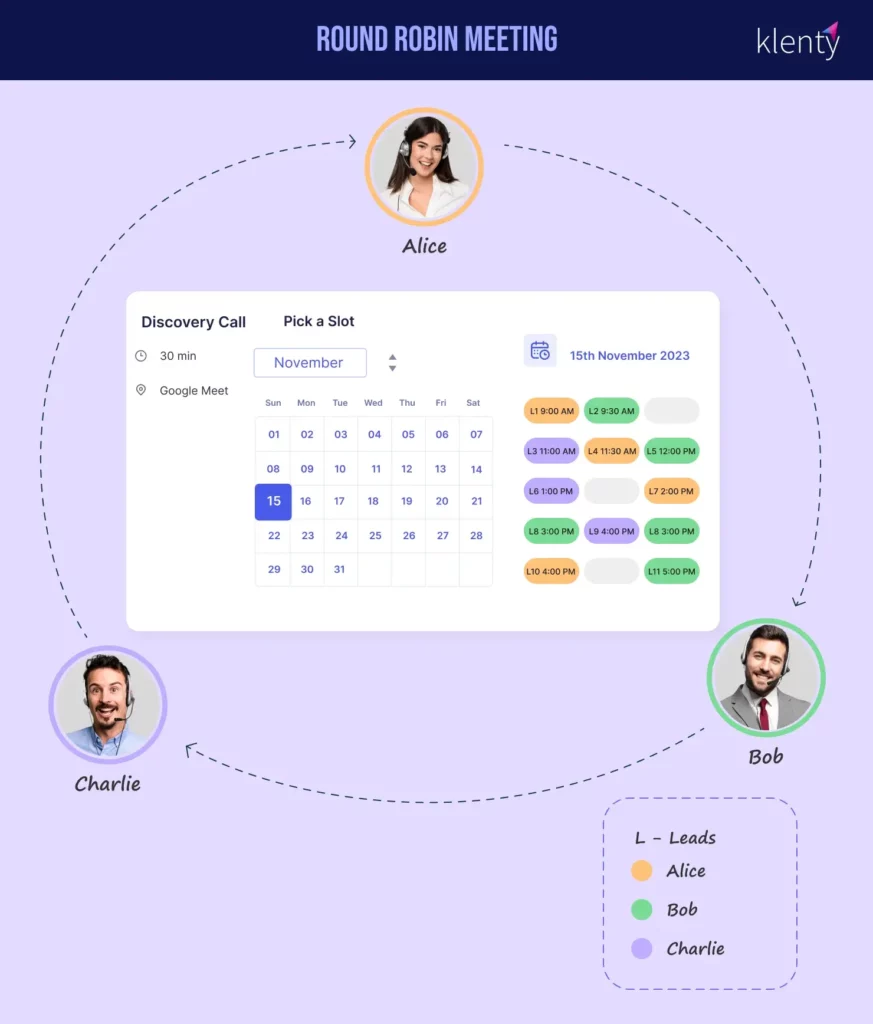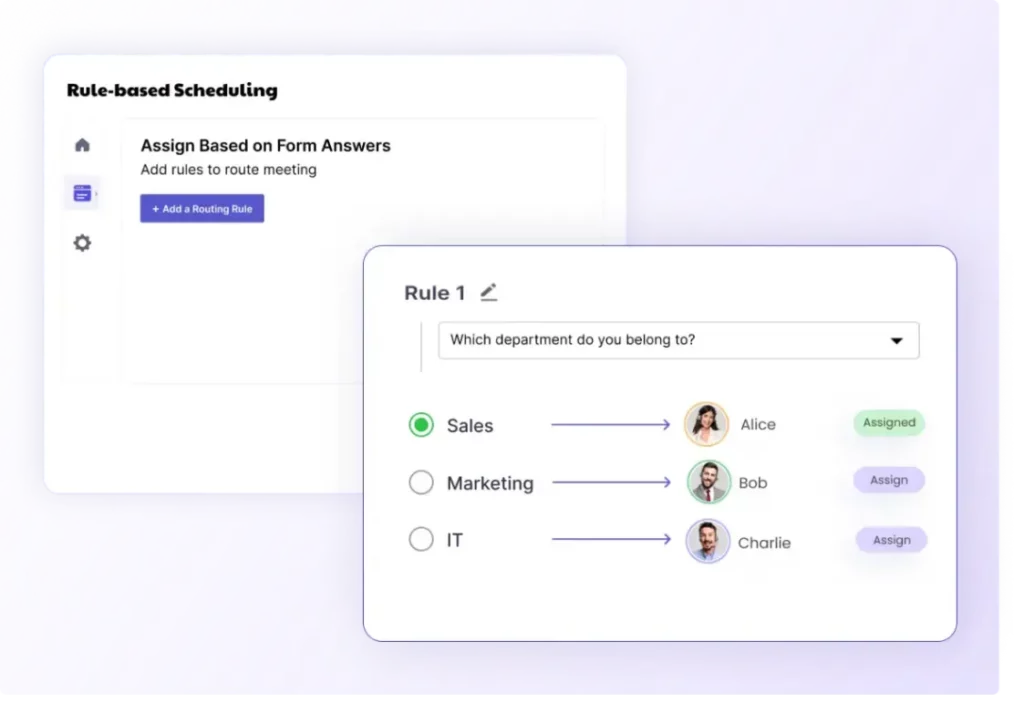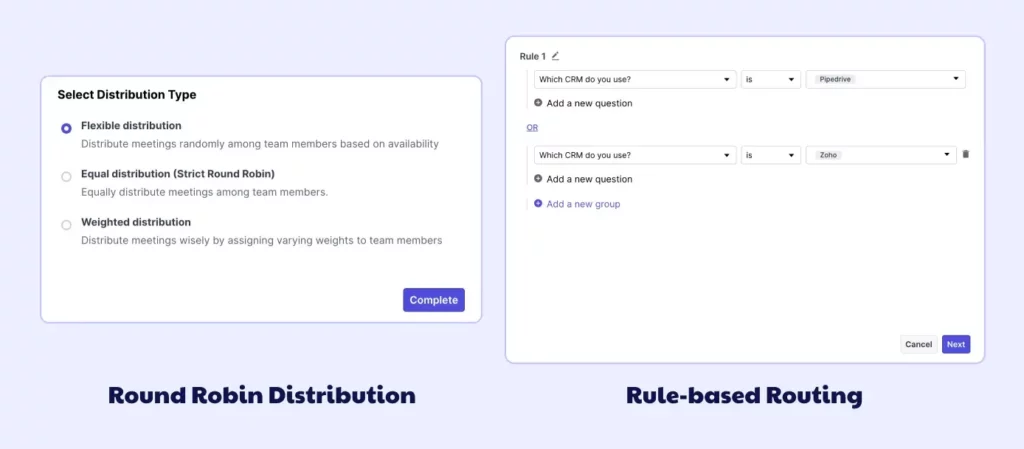All sales teams strive to achieve a steady inflow of leads. But that’s just the beginning of your sales journey.
For sales managers, the biggest challenge is distributing these leads equally to their sales reps so that all of them get an equal opportunity to hit their quotas.
Without a clear strategy to do this, managers can run into problems like:
- Overburdening only a select number of reps in the team,
- Assigning leads to unavailable reps, and
- Not assigning leads at the right time to reps.
Ultimately, if you don’t have a plan in place to distribute leads among reps, you’re staring at a loss in pipeline and revenue. That’s definitely not the ideal destination for your sales journey.
So, how can you overcome these challenges and distribute leads efficiently?
One of the popular techniques you can use to achieve this is round robin meeting distribution, a system that ensures equitable lead distribution and efficient scheduling.
In this blog, we’ll delve into the concept of round robin meetings, why it's essential, and how to effectively use it to improve various aspects of your business operations.
What Is a Round Robin Meeting?
In the context of sports, round robin refers to a competition in which every participant gets a chance to play every other participant by taking turns.
Extending this concept to sales meetings, round robin refers to the method of distributing leads or tasks evenly among a group of individuals or teams in a rotational manner, where each rep takes their turn in sequence.
This method is commonly used in sales and customer support environments to ensure everyone in the sales team gets an equal opportunity to handle leads, customers, or assignments.
Here's a simple example to help you understand better.
Let’s say you have a team of 3 salespeople: Alice, Bob, and Charlie. The team gets 11 leads on a particular day. Here’s a brief illustration on how these leads will be distributed among the reps through round robin scheduling:
Round 1:
- Lead 1 goes to Alice.
- Lead 2 goes to Bob.
- Lead 3 goes to Charlie.
Round 2:
- Lead 4 goes to Alice. It starts over from the beginning after reaching the last person.
- Lead 5 goes to Bob.
- Lead 6 goes to Charlie.
- Lead 7 goes to Alice.
Round 3:
- Lead 8 goes to Bob. Since Alice had her turn in the previous round, the next lead goes to Bob in this round.
- Lead 9 goes to Charlie.
- Lead 10 goes to Alice.
- Lead 11 goes to Bob. And the cycle continues…

This way, the system will distribute each lead equally among your sales team.
Why Do You Need Round Robin Meeting Distribution?
According to Marketo, 80 percent of marketing leads are ignored, and this poor lead management costs businesses an estimated $1 trillion per year.
By adopting a systematic approach to lead distribution, organizations can ensure faster response times, equitable workload distribution, and ultimately achieve overall efficiency in managing leads.
Let's delve deeper into the key reasons why incorporating round robin distribution is crucial for achieving these objectives.
1. Rapid Lead Routing for Sales Reps
Speed to lead is crucial. The quicker your sales rep responds, the higher the chance of converting leads.
A study by Harvard Business Review found that companies reaching out to prospects within an hour of getting a query were almost 7 times more likely to qualify the lead compared to those reaching out later, even just by an hour.
The study also reveals that only 37% of businesses respond to their lead within an hour, 16% respond within one to 24 hours, 24% take more than 24 hours, and 23% of the companies never respond at all.
With the round robin meeting model, you can strike the iron while it’s hot. By swiftly distributing qualified leads among sales representatives in a circular manner, this method ensures there are no disruptions to meetings and leads are promptly allocated to each team member in sequence.
2. Assists With Equal Lead Routing
Apart from the round robin model, another model that's used to distribute leads is the cherry-picking system. But its reputation isn't all that great when it comes to fairness.
Cherry-picking is where managers manually assign leads based on their skills, expertise, and experience level. On paper, this method may seem to be the best, but may not be the fairest.
It can favor experienced reps by allocating all the high-quality leads. Newer reps might not get the same quality leads as experienced reps get, leading to team friction and demotivation, which could impact their overall performance.
On the other hand, the round-robin meeting method ensures that every team member has an equal chance to engage with high-value leads, preventing any disproportionate allocation and fostering a fair distribution of meetings. This not only maximizes the potential for successful conversions but also cultivates a sense of equality and motivation among team members to hit their quota.
3. Assigns Leads by Availability
Sales reps often have varying schedules, and their availability can fluctuate based on meetings, appointments, or other commitments.
Round robin meeting distribution takes into account the availability of each team member, ensuring that leads are assigned to those who currently have an open time slot.
If a sales rep is unavailable during certain hours of the day or for longer durations, you can update this in the system, and it will automatically route the lead to the next available team member in the round robin queue, minimizing response times and optimizing workload balance.
Let's go back to our reps— Alice, Bob, and Charlie. They all have different schedules and may be unavailable sometimes.
- If Alice is on vacation, the system skips her turn and gives the lead to Bob.
- Bob then takes the lead after Alice
- Charlie gets the next lead
Bob and Charlie will continue to take the leads in a rotational manner, and the system starts routing leads to Alice only when she is available.
4. Optimize Lead Distribution Strategy
Among all the lead distribution models, round robin is popular as it gives unique insights into how leads are allocated and managed. This helps managers measure sales performance, identify areas for improvement, and make informed decisions to optimize lead distribution.
Here’s how it helps in optimizing the lead distribution process:
- Individual Performance Analysis: By using round robin, you can track each salesperson's performance based on the number of leads they handle, their lead response time, and conversion rates. This allows you to identify potential problem areas and chalk out any sales coaching opportunities.
- Workload Distribution: Managers can determine how evenly tasks are distributed among team members. This helps identify if there is an imbalance in workload distribution, allowing for adjustments if necessary.
How To Use Round Robin Meetings?
So far, we’ve covered ground on what a round robin meeting is, how it works, and why you need a round robin distribution system. Let's explore how to effectively implement them within your organization using the following 3 steps:
1. Establish Detailed Round Robin Distribution Logic
Here are 3 different round robin techniques to distribute leads:
- Flexible Routing allows you to distribute meetings randomly based on availability logic. For example, if Charlie is available at that moment, they get the meeting. This ensures that the prospects are not kept waiting for too long.
- Strict or Equal Routing allows you to allocate equal meeting slots. In this case, if Charlie has 3 meetings, Alice and Bob will get 3 meetings each. This way, your team gets an equal share of leads to meet quota, ultimately boosting revenue.
- Weighted routing lets you distribute leads based on pre-defined weightage. This weightage means managers get to decide the percentage of meetings each rep gets. This rule is helpful when you have a new rep in your team, and you want them to start slow and at the same time handle quality leads. Say if Alice is more experienced than Bob, then for every meeting Bob gets, Alice gets 4.
2. Route Leads Based on Rules
You can further filter the sales leads to match them to the right rep with rule-based scheduling.
In rule-based scheduling automation, you route the leads based on their form answers. This helps when you have a large, multi-disciplinary sales team.
Once you enable this automation, all the leads who fill out the form and book meetings will be automatically routed to the reps based on the routing rules you had set.
Let’s understand this with an example:
Say you have a form for prospects to fill out before scheduling a product demo. It has one question and 3 options for answers, and you want to route them based on their answers.
You could set the rules like this:
- Rule 1: If the lead answers option ‘a’, route them to Alice.
- Rule 2: If the lead chooses option ‘b’, route them to Charlie.
- Rule 3: If the lead chooses option ‘c’, route them to Bob.

In scenarios where you have more than one rep with the skills and expertise to handle the leads from the same category, you can further distribute the leads based on the round robin distribution logic you’ve set.
3. Update Your Routing System Regularly
As your team evolves, you might hire new sales reps, make adjustments in staff, or change responsibilities. Review the routing system every month or quarter to see whether you need to make changes to rules to reflect any changes that might have occurred.
For example, if Bob leaves the team, you can update the event logic by removing Bob from the sequence to distribute new leads evenly among existing team members.
If a new rep joins your team, add them to the sequence and update the system by choosing a suitable round robin meeting distribution technique to distribute leads.
How Can Schedule IQ Help With Round Robin Meetings?
Implementing the above strategy will require you to have a platform like Schedule IQ.
Schedule IQ by Klenty is a meeting scheduling and lead routing platform that automates the entire process of lead distribution based on the round-robin distribution logic and rules, ensuring that the right rep is assigned for every prospect and no opportunity is missed.
The platform offers 3 advanced round robin techniques to ensure you always route the right leads to the right rep:
- Flexible Routing randomly assigns meetings based on availability.
- Strict or Equal Routing allocates equal meeting slots.
- Weighted Routing assigns reps to leads based on pre-defined weightage.

Schedule IQ also offers features to customize your rep’s availability, personalize your meeting booking page, and send automated reminders.
With advanced website calendar embeds and forms, Schedule IQ helps website visitors book a meeting with sales reps immediately, providing a seamless appointment experience.
Want to see how Schedule IQ helps you efficiently schedule meetings and manage your leads? Book a demo now!


